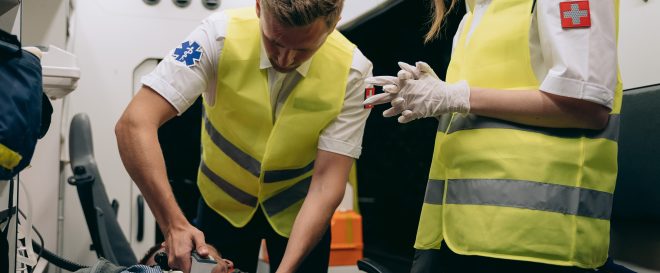6 Essential AED Accessories You Must Consider

Consider a scenario in which a person’s life is a stake; each second matters, and the accessibility of just one device determines life and death. Although this circumstance could appear frightening, it is a reality that emergency responders, medical experts, and even regular people in urgent situations must deal with. The Automated External Defibrillator (AED) is the gadget we’re referring to, a stunning technological advancement that has completely changed how we respond to cardiac emergencies.
In sudden cardiac arrest (SCA) situations, an AED is a handheld electrical device that shocks the heart with electricity. Its main objective is to reestablish the heart’s regular rhythm by delivering regulated electrical signals. AEDs have improved in use and accessibility, making emergency interventions possible for those with little medical expertise.
While the AED itself is undeniably a lifesaver, there are several essential accessories that can further enhance its effectiveness and ease of use. In this blog, we explore essential AED accessories you must consider.
AED Training Kit
A comprehensive AED training kit provides the necessary tools and resources to conduct regular CPR and AED training sessions. It typically includes training pads, a remote control, and a training module that simulates real-life scenarios.
The training kit allows users to practice using the AED without needing an emergency, ensuring they gain familiarity with the device’s operation and build confidence in its usage.
By conducting regular training sessions using the AED training kit, individuals become proficient in recognizing cardiac emergencies, performing CPR, and effectively using the AED. It prepares potential responders to act swiftly and appropriately during real-life cardiac incidents, improving the chances of a positive outcome.
Moreover, the training kit facilitates the dissemination of knowledge and empowers a broader group of individuals to become capable responders in emergencies. It is advisable to purchase them from a reputable platform like https://store.avive.life/, to acquire an affordable and reliable AED training kit or other AED accessories.
AED Cabinet or Wall Mount
Yes, an AED cabinet or wall mount is an essential accessory when implementing an automated external defibrillator (AED) program. Here’s why:
- Accessibility: Placing the AED in a visible and easily accessible location is crucial for a prompt response during cardiac emergencies. An AED cabinet or wall mount ensures the device is prominently displayed and readily available to responders.
- Protection: A sturdy cabinet or wall mount helps protect the AED from dust, moisture, and physical damage that could compromise its functionality.
- Security: A locked cabinet provides security and helps prevent unauthorized use or tampering with the AED. It is particularly important in public settings where the AED needs to be accessible to trained individuals but protected from theft or misuse.
- Visibility and Awareness: AED cabinets often include clear signage indicating the presence of an AED. This signage helps raise awareness among people in the vicinity, informing them of the availability of an AED and its potential life-saving capabilities.
AED Battery and Electrode Pads
Here’s why AED batteries and electrode pads are crucial:
- Device Functionality: AED batteries power the device, allowing it to function effectively during a cardiac emergency. The AED cannot deliver life-saving shocks without a fully charged and functional battery. It is essential to have spare batteries readily available to ensure the AED is always ready for use.
- Shelf Life and Expiration: Electrode pads, also known as defibrillation pads or electrodes, have a limited shelf life and expiration date. Over time, the adhesive on the pads can degrade, reducing their effectiveness. Expired or worn-out pads may not come into contact properly with the patient’s chest, compromising the delivery of electric shocks.
- Quick Response: Having readily available spare batteries and electrode pads allows for a swift response. When the AED is accessible and equipped with fresh batteries and pads, potential responders can initiate defibrillation promptly, increasing the chances of a positive outcome.
- Maintenance and Preparedness: Regular maintenance of the AED includes checking the battery charge and the condition of the electrode pads. Keeping spare batteries and electrode pads on hand ensures that the AED remains in optimal working condition.
AED Signage
Here’s why AED signage is crucial:
- Visibility and Awareness: Clear and prominent AED signage ensures that people in the vicinity can quickly and easily locate the AED during emergencies. The signage acts as a visual cue, drawing attention to the presence and location of the AED.
- Rapid Response: AED signage helps minimize response time by guiding individuals to the nearest AED. Easily identifiable signage can make a significant difference in promptly accessing and initiating life-saving measures.
- Public Confidence: AED signage instills confidence in the public, reassuring them that your organization or facility is prepared to handle cardiac emergencies. Visible signage demonstrates a commitment to safety and the well-being of visitors, employees, or customers, fostering a sense of trust and security.
- Compliance: In many jurisdictions, displaying AED signage is a legal requirement. Regulatory bodies may specify the signage’s size, color, and content.
- Training and Familiarity: AED signage can include instructional visuals or text, reminding potential responders about the location and proper usage of the device. It reinforces training and familiarizes individuals with the AED’s placement.
AED Maintenance and Inspection Tags
Inspection tags serve as a systematic and visual reminder of the AED’s maintenance schedule and inspection history. By attaching maintenance and inspection tags to the AED cabinet or wall mount, important information such as the last inspection date, battery replacement, electrode pad expiration, and other crucial details can be recorded.
These tags help ensure that the AED is regularly checked, maintained, and kept in optimal working condition. They provide a reliable AED maintenance history record, allowing for easy tracking and accountability.
AED Pediatric Pads
These specialized pads are designed specifically for infants and children, delivering lower energy shocks appropriate for their size and age. By having pediatric pads as part of your AED accessories, you ensure that the AED can be effectively used on individuals of all ages.
In the event of a pediatric cardiac emergency, these pads enable responders to provide appropriate defibrillation while minimizing the potential risks associated with adult pads.
Conclusion
Implementing an effective automated external defibrillator (AED) program requires careful consideration of the above essential accessories. These accessories ensure that the AEDs are readily available, properly protected, and in optimal working condition when needed during cardiac emergencies.
By investing in and prioritizing these essential AED accessories, organizations and individuals can significantly improve their emergency preparedness, increase the likelihood of timely defibrillation, and ultimately save lives. Remember to consult with AED manufacturers and professionals to determine the most suitable accessories for your specific AED model and program requirements.



